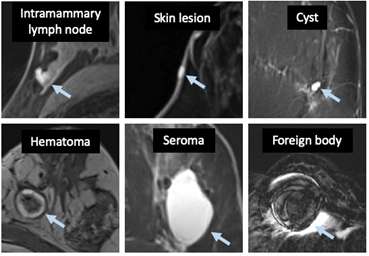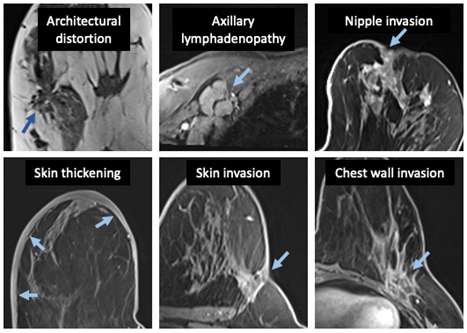MRI Sequences and How to Read a Breast MRI and BI-RADS
by Tracie Kong, MD and Laura Doepke, MD
MRI Sequences
The standard breast MRI acquisition technique should include the following sequences at minimum:
- Bright-fluid (T2-weighted) sequence: Visualization of cysts, lymph nodes, benign lesions, and other high water-content structures.
- Multiphase T1-weighted fat suppressed sequences, including a pre-contrast sequence which allows for evaluation of the contrast uptake and enhancement kinetic profiles of lesions.
Additional sequences, depending on the indication, patient history, and institutional protocols may include:
- Non-fat saturated T1-weighted sequence: Distinction of fat-containing lesions such as fat necrosis, blood products, and architectural distortion.
- Diffusion-weighted imaging: Demonstration of the random movement of water molecules, which can assist in characterizing lesions.
Post-processing techniques may generate additional data, including:
- Maximum intensity projection (MIP) images
- Color map overlays of the enhancement curve distribution
- Time-signal intensity curves
The protocol may be adjusted for breast implants using silicone specific sequences to assess silicone implant integrity. The field of view should cover the entire bilateral breasts from the axillary tail to the inframmmary fold, while excluding the posterior thorax to optimize resolution. Ultrafast or abbreviated MRI techniques are also being studies and implemented to allow for high throughput screening and diagnostic imaging.
How to Read a Breast MRI
Interpreting a breast MRI involves distinguishing suspicious lesions from background parenchymal enhancement. Approaches vary and depend on the acquisition protocol and clinical context. The following is one suggested approach:
- Review clinical history.
- Evaluate technical quality of the images, including contrast bolus, motion artifact, and fat suppression.
- Review MIP images to assess background parenchymal enhancement and suspicious enhancing regions. Assess amount of fibroglandular tissue.
- Characterize lesions on the multiphase T1-weighted sequences.
- Correlate regions of interest using T2-weighted sequences, kinetics data, and other available sequences.
- Compare with prior studies.
- Review other structures included in the field of view, including the lymph nodes, chest wall, and other structures visible in the thorax and upper abdomen.


Each important finding should be described using the BI-RADS lexicon. Findings that demonstrate enhancement include foci, masses, and non-mass enhancement, which are detailed in separate articles. Other findings that may enhance include lymph nodes and skin lesions. Non-enhancing findings include cysts, post-operative collections, and foreign bodies that cause signal voids (Fig. 3). Benign lesions should be noted as such to avoid unnecessary intervention.

Associated features should also be discussed using the BI-RADS lexicon and used to form the final assessment. Associated features may include nipple retraction and/or invasion; skin retraction, thickening, or invasion; and pectoralis muscle and/or chest wall invasion (Fig. 4).

The final assessment and management of a breast MRI examination should follow the BI-RADS categories, which are based on the BI-RADS categories developed for mammography (Table 1).
| Assessment | Management | Likelihood of Malignancy |
|---|---|---|
| Category 0: Incomplete – Need Additional Imaging Evaluation | Recommend additional imaging: mammogram or targeted US | N/A |
| Category 1: Negative | Routine breast MRI screening if cumulative lifetime risk ≥ 20-25% | Essentially 0% |
| Category 2: Benign | Routine breast MRI screening if cumulative lifetime risk ≥ 20-25% | Essentially 0% |
| Category 3: Probably Benign | Short-interval (6-month) follow-up | ≥ 0% but ≤ 2% |
| Category 4: Suspicious | Tissue diagnosis | > 2% but < 95% |
| Category 5: Highly Suggestive of Malignancy | Tissue diagnosis | ≥ 95% |
| Category 6: Known Biopsy-Proven Malignancy | Surgical excision when clinically appropriate | N/A |
Key Teaching Points:
- The standard breast MRI acquisition technique includes a bright-fluid (T2-weighted) sequence and multiphase T1-weighted fat suppressed sequences. Additional sequences and post-processing techniques can be added.
- The BI-RADS lexicon should be used when reporting breast MRI examinations.
- The BI-RADS categories for assessment and management developed for breast MRI are based on the BI-RADS categories developed for mammography.
References
- Lee CI, Lehman CD, Bassett LW, eds. Breast MRI Overview. Breast Imaging. Oxford University Press; 2018:81-91.
- Mann RM, Cho N, Moy L. Breast MRI: State of the Art. Radiology. 2019;292(3):520-536. . PMID: 31361209
- D’Orsi CJ, Sickles EA, Mendelson EB, Morris EA, et al. ACR BI-RADS® Atlas 5th Edition, Breast Imaging Reporting and Data System. Reston, VA, American College of Radiology; 2013.